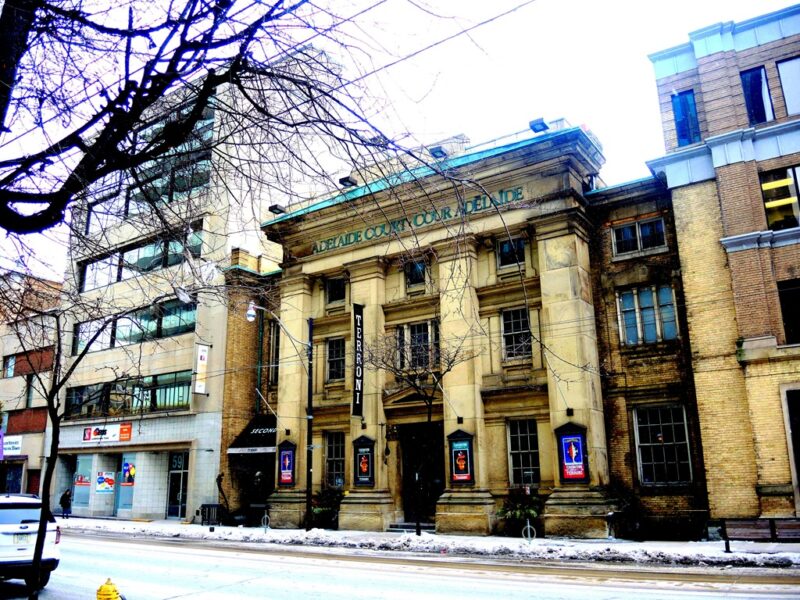City of Toronto Archives, Series 1257, S1057, It. 8480 (1)
The Westwood Theatre was at 3743 Bloor Street West, at the intersection of Bloor, Dundas West, and Kipling Avenue. The intersection is known as “six points,” and it has a triangular piece of land sandwiched between the busy arterial roadways. The design of the Westwood Theatre was more utilitarian than aesthetic, as it was a simple architectural box, designed by Kaplan and Sprachman.
When it was built, the extensive parking lot in front of the theatre had great appeal in post-war suburban Toronto. More people were purchasing automobiles, this mode of transportation becoming the king of the road. The Westwood was one of the first Toronto theatres constructed purposely to appeal to the suburbanites with cars. The concept of a theatre within a mall with other shops, and with enormous parking facilities for customers, became the wave of the future. Today, this formula is copied throughout many urban areas, and remains the preferred method of theatre construction in communities not well serviced by public transportation. However, today the malls tend to be enormous, with numerous other stores and shops.
The Westwood opened to great fanfare on February 28, 1951 in a ceremony presided over by Leslie Frost, the Premier of Ontario. The featured films were “Laughter in Paradise” with Alastair Sim, and “You Never Can Tell,” starring Dick Powell and Peggy Dow. The theatre’s auditorium contained almost 1000 rubber-foam cushion seats. It also possessed Canada’s first “floating screen,” which meant that hidden behind the screen were panels that separated it from the wall, creating the illusion that it was floating. It sounds more like an advertising gimmick rather than any real advancement in theatre design. The theatre’s owner was United Century Theatre Ltd., but the licence was held by 20th Century Theatre Corp. The first manager of the Westwood was Dudley Dumont.
I remember attending the theatre many times. The first automobile I ever owned was a flaming red 1963 Pontiac Acadian. I was very proud to have “wheels,” and on a Friday or Saturday evening sometimes drove to the Westwood with friends. The large parking lot did indeed encourage us to attend. The theatre did not screen first-run films, so offered a double-bill to compensate. I recall that the lobby was spacious, and I never noticed that the architecture and interior were rather simple, especially compared to the theatres located downtown.
The theatre closed in 1998. I do not know if at one time it was ever converted for other purposes, but the building did remain vacant for many years. It was finally demolished in 2013.
The Westwood Theatre in August of 2013. It had been vacant for many years. Photo Stephenson/Kuhn.
August 2013, after the demolition of the theatre had commenced. Photo, Stephenson/Kuhn.
To view the Home Page for this blog: https://tayloronhistory.com/
To view previous blogs about other movie houses of Toronto—old and new
https://tayloronhistory.com/2013/10/09/links-to-toronto-old-movie-housestayloronhistory-com/
To view links to other posts placed on this blog about the history of Toronto and its buildings:
https://tayloronhistory.com/2013/10/08/links-to-historic-architecture-of-torontotayloronhistory-com/
Recent publication entitled “Toronto’s Theatres and the Golden Age of the Silver Screen,” by the author of this blog. The publication explores 50 of Toronto’s old theatres and contains over 80 archival photographs of the facades, marquees and interiors of the theatres. It also relates anecdotes and stories from those who experienced these grand old movie houses.
To place an order for this book:
Theatres Included in the Book
Chapter One – The Early Years—Nickelodeons and the First Theatres in Toronto
Theatorium (Red Mill) Theatre—Toronto’s First Movie Experience and First Permanent Movie Theatre, Auditorium (Avenue, PIckford), Colonial Theatre (the Bay), thePhotodome, Revue Theatre, Picture Palace (Royal George), Big Nickel (National, Rio), Madison Theatre (Midtown, Capri, Eden, Bloor Cinema, Bloor Street Hot Docs), Theatre Without a Name (Pastime, Prince Edward, Fox)
Chapter Two – The Great Movie Palaces – The End of the Nickelodeons
Loew’s Yonge Street (Elgin/Winter Garden), Shea’s Hippodrome, The Allen (Tivoli), Pantages (Imperial, Imperial Six, Ed Mirvish), Loew’s Uptown
Chapter Three – Smaller Theatres in the pre-1920s and 1920s
Oakwood, Broadway, Carlton on Parliament Street, Victory on Yonge Street (Embassy, Astor, Showcase, Federal, New Yorker, Panasonic), Allan’s Danforth (Century, Titania, Music Hall), Parkdale, Alhambra (Baronet, Eve), St. Clair, Standard (Strand, Victory, Golden Harvest), Palace, Bedford (Park), Hudson (Mount Pleasant), Belsize (Crest, Regent), Runnymede
Chapter Four – Theatres During the 1930s, the Great Depression
Grant ,Hollywood, Oriole (Cinema, International Cinema), Eglinton, Casino, Radio City, Paramount, Scarboro, Paradise (Eve’s Paradise), State (Bloordale), Colony, Bellevue (Lux, Elektra, Lido), Kingsway, Pylon (Royal, Golden Princess), Metro
Chapter Five – Theatres in the 1940s – The Second World War and the Post-War Years
University, Odeon Fairlawn, Vaughan, Odeon Danforth, Glendale, Odeon Hyland, Nortown, Willow, Downtown, Odeon Carlton, Donlands, Biltmore, Odeon Humber, Town Cinema
Chapter Six – The 1950s Theatres
Savoy (Coronet), Westwood
Chapter Seven – Cineplex and Multi-screen Complexes
Cineplex Eaton Centre, Cineplex Odeon Varsity, Scotiabank Cineplex, Dundas Square Cineplex, The Bell Lightbox (TIFF)
![f1257_s1057_it8480[1] Westwood f1257_s1057_it8480[1] Westwood](https://tayloronhistory.files.wordpress.com/2013/12/f1257_s1057_it84801-westwood_thumb.jpg)


![cid_E474E4F9-11FC-42C9-AAAD-1B66D852[2] cid_E474E4F9-11FC-42C9-AAAD-1B66D852[2]](https://tayloronhistory.files.wordpress.com/2014/09/cid_e474e4f9-11fc-42c9-aaad-1b66d8522_thumb19.jpg)

